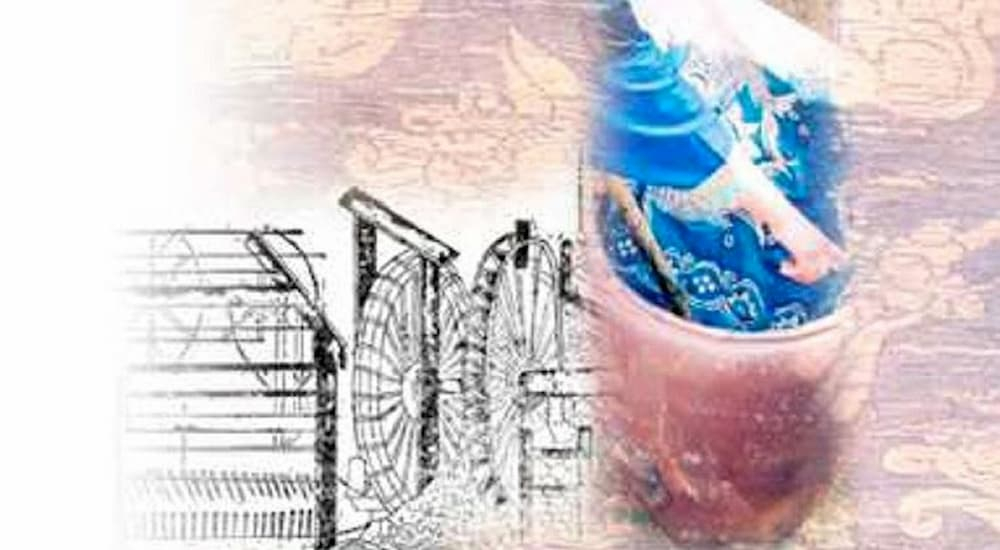
中國古代紡織與印染
Splendid
Chi Culture
Topic
Weaving, Printing and Dyeing of Textiles in Ancient China
In antiquity, early humans made ropes and wove nets to survive. Thus, weaving was created, and the earliest weaving tool, the spindle, emerged. Before the Qin dynasty (221–206 BCE), the entire set of weaving techniques had been gradually formed. These skills included cultivating and processing fiber plants, spinning, weaving, and dyeing. The most common weaving tool, the spinning wheel for silk, appeared. There were two types of wheel: one which was operated by hand, and another operated by foot. The foot-operated spinning wheel freed the operator’s hands. With both hands working, the quality and the quantity of the silk were raised significantly. The foot-operated spinning wheel was typical of ancient manually operated reeling tools. Entering the Han (206 BCE–220 CE) and Tang (618–907) periods, weaving technology reached unprecedented levels. The multi-treadle loom was invented, which could weave complicated and geometric patterns. As the technology of weaving progressed so too did the raised designs woven into the fabric. Over time, the technique transformed from a manual to a mechanical method; and the raised design was woven by using the wefts instead of the warps. In the meantime, a technique for making velvet was also invented. Dyeing techniques also improved. Batik (wax printing) came into use. Batik is a type of wax-resist dyeing, a technique that uses hot dye-resistant wax to “draw” patterns and designs on cloth. When the wax cools, the cloth is immersed in the dye. Afterwards, the dyed piece of cloth is placed in boiling water to remove the wax. Irregular patterns of crackles are formed when the wax is cooling off, and these appear as part of the design. These irregular crackles are unique in design. The most representative textile during this period was damask silk with ice crackle pattern. Bai Juyi (772–846) praised the “liao ling” (reeled silk) produced in Zhejiang during the Sui and Tang dynasties (late sixth century–early tenth century). It was distinctive and, according to the poet was unlike “silk gauze, raw silk, twill damask, or patterned tabby weave silk.” It has continued to enjoy a fine reputation since that time.
During the Song and Yuan dynasties (mid tenth century–ca. mid fourteenth century), the political center of the country moved southward. The distribution networks and the textile industry itself underwent great changes. Along with the inland cultivation of cotton and technical breakthroughs in processing, cotton planting began to spread all over China. Cotton replaced hemp as the main material for clothing. Among improvements in cotton weaving techniques, Granny Huang Dao’s contribution must be recognized. Granny Huang Dao left her home town and moved to Yazhou (modern Sanya area, Hainan) when she was young. She passed through many places before finally returning home. She combined weaving techniques that she learned from the Li People while she was residing in Yazhou with traditional Chinese methods. She further improved and created a set of new techniques which she taught her fellow villagers. Cotton textile production in her hometown was forever changed because of her.
The kesi (incised silk) technique also had reached its maturity after the Song and Yuan dynasties and was used not only for practical use, but also became an appreciated art form.
During the Ming and Qing dynasties (fourteenth century–early twentieth century), the scope of production in both government owned and privately owned weaving industries had surpassed that of previous eras. Large, new and flourishing cities emerged near several major centers of weaving, including Hangzhou and Suzhou. Embroidery also became a required skill for women. Embroidery reached impressive heights during the Ming and Qing period when four major types of embroidery with distinctive features developed: Su (Suzhou) embroidery, Yue (Cantonese) embroidery, Shu (Sichuan) embroidery, and Xiang (Hunan) embroidery. These four styles were renowned. For example, the production of Shu embroidery was centered at Chengdu. Its designs are sparsely arranged in blue against a white background, which was marked with simple and ancient styles. It features bright and neat designs, with the blank background and the design integrated appropriately. The lines of stitches are neat and closely arranged covering the background completely. The blank part is barely discernible. The embroidery is world famous for the incredible evenness of its edge, as if it had been cut off by a knife.
Chinese silk was transmitted to Eurasia in the fifth or the sixth century BCE, and was later indirectly introduced to Europe. However, it was much later that silk weaving techniques were introduced outside of China. They were first transmitted to Turpan and Khotan in modern Xinjiang province between the fifth and the sixth century; they were further transmitted to Persia. After the seventh century, Persia became the most important silk weaving center in the world outside of China.



